Unit 5 Signs 第一课时教案(含设计意图)
文档属性
| 名称 | Unit 5 Signs 第一课时教案(含设计意图) | 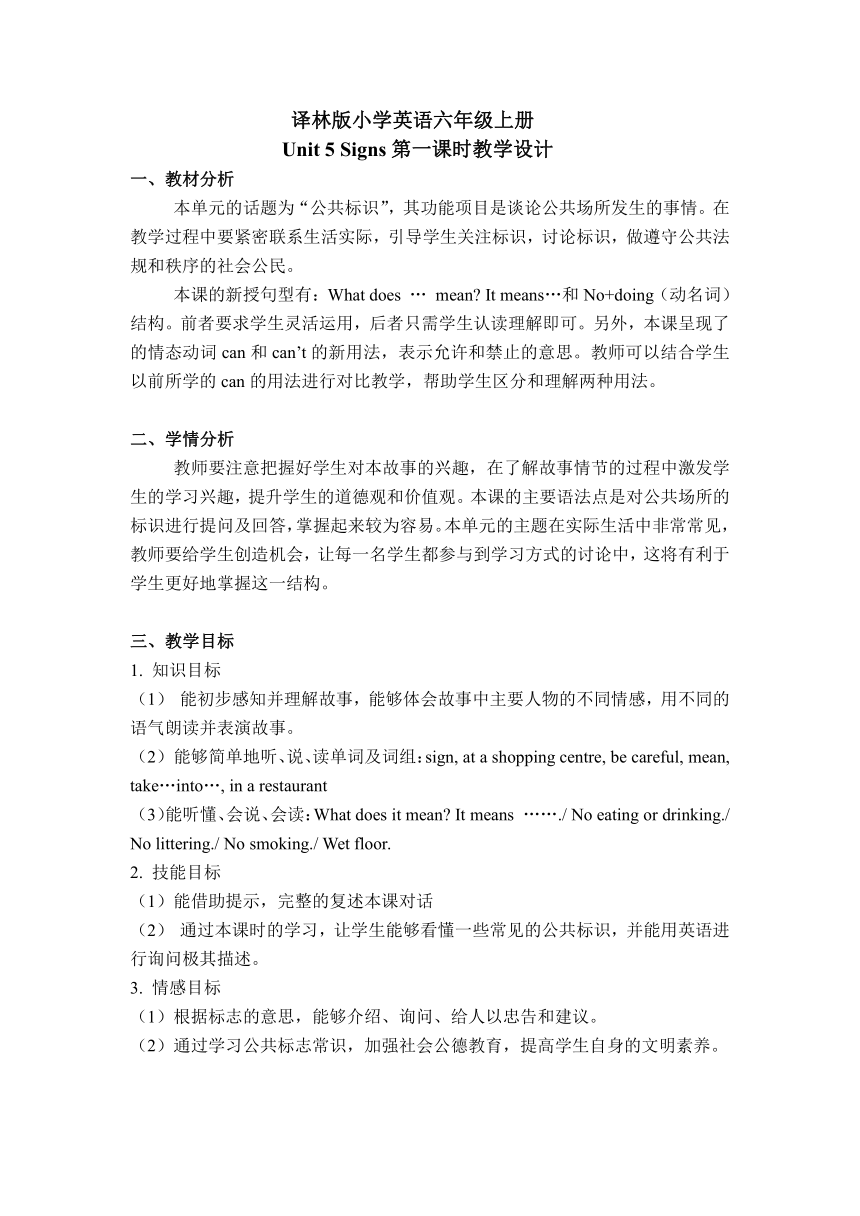 | |
| 格式 | docx | ||
| 文件大小 | 671.2KB | ||
| 资源类型 | 教案 | ||
| 版本资源 | 牛津译林版 | ||
| 科目 | 英语 | ||
| 更新时间 | 2022-01-10 20:57:28 | ||
图片预览

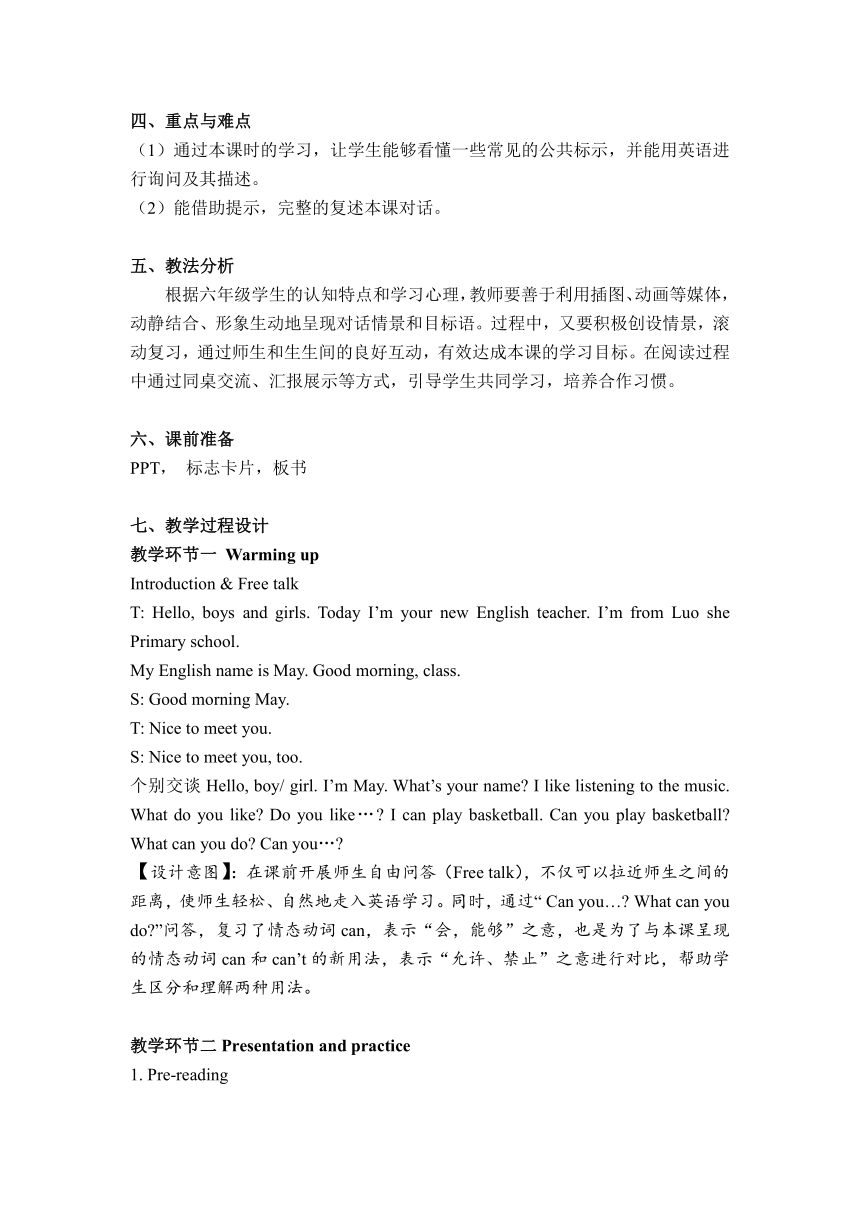
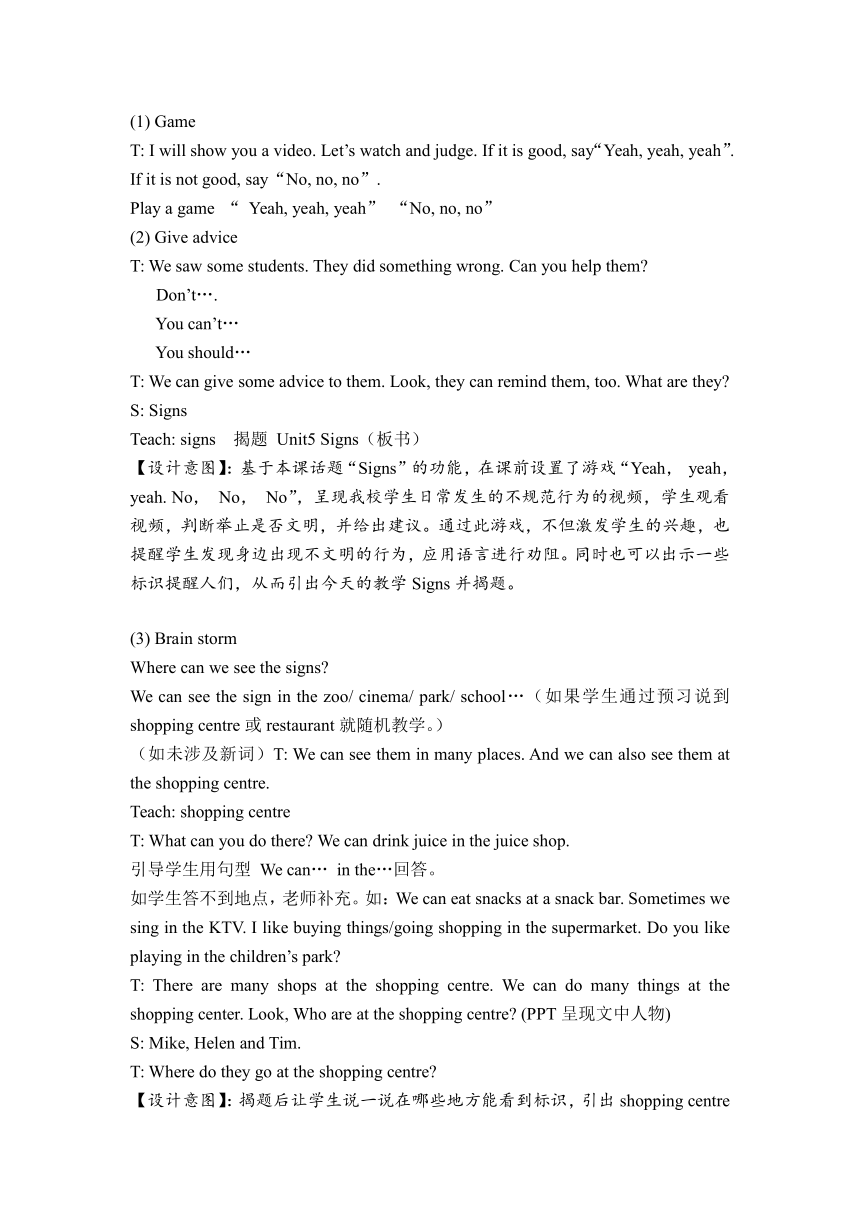
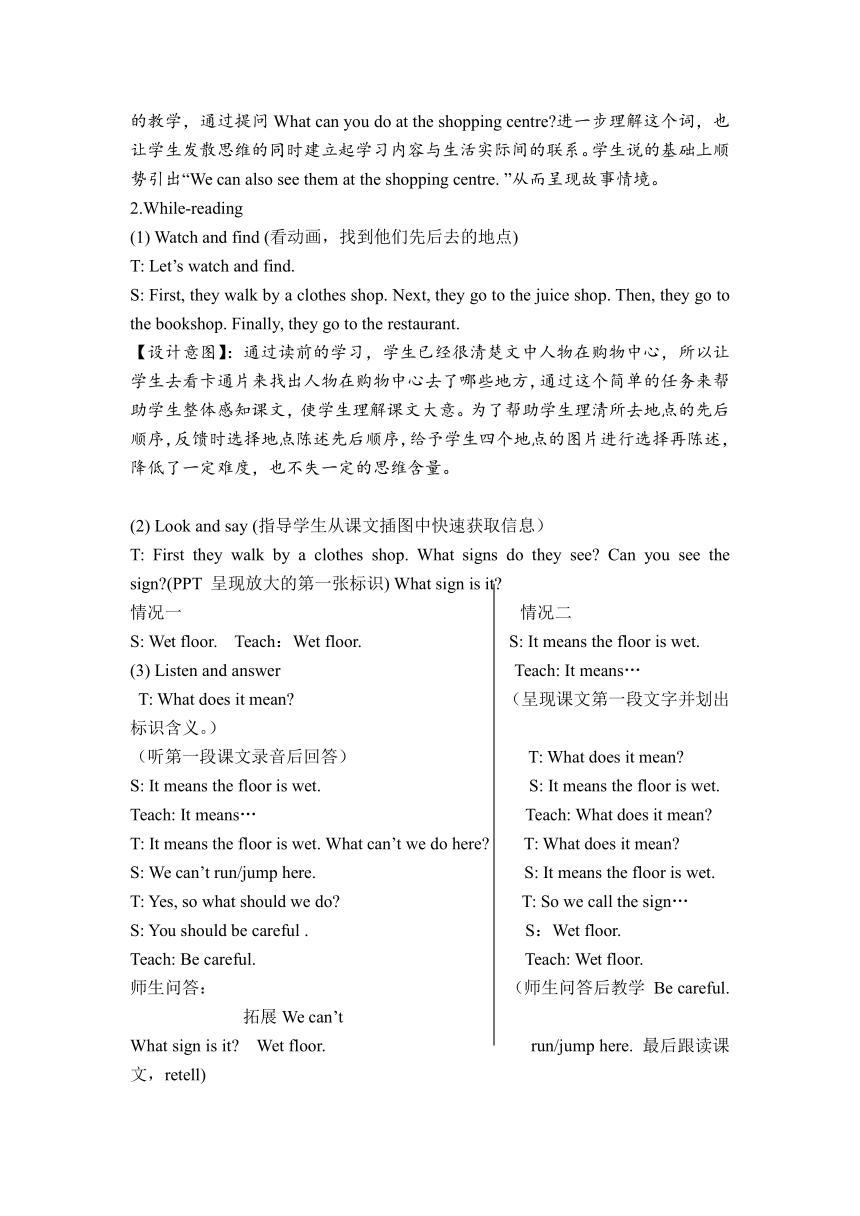
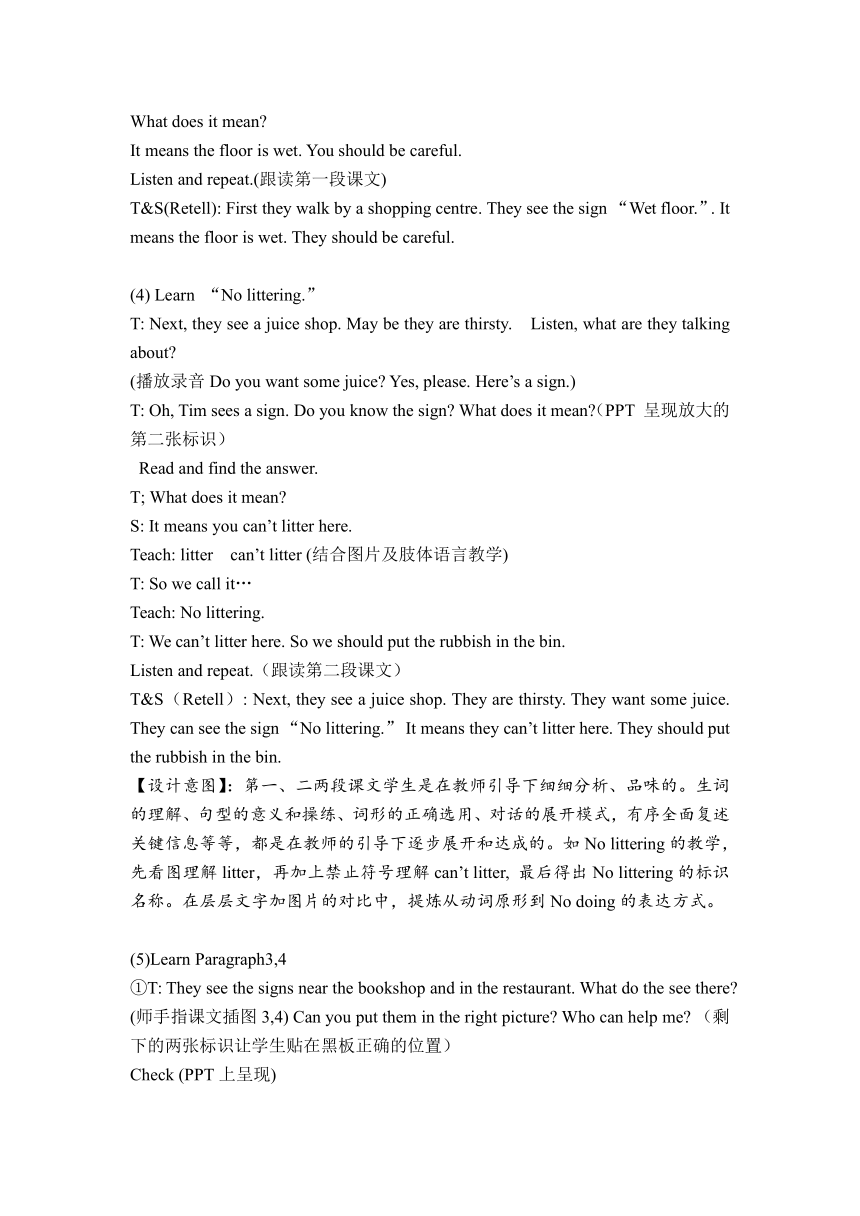
文档简介
译林版小学英语六年级上册
Unit 5 Signs第一课时教学设计
一、教材分析
本单元的话题为“公共标识”,其功能项目是谈论公共场所发生的事情。在教学过程中要紧密联系生活实际,引导学生关注标识,讨论标识,做遵守公共法规和秩序的社会公民。
本课的新授句型有:What does … mean It means…和No+doing(动名词)结构。前者要求学生灵活运用,后者只需学生认读理解即可。另外,本课呈现了的情态动词can和can’t的新用法,表示允许和禁止的意思。教师可以结合学生以前所学的can的用法进行对比教学,帮助学生区分和理解两种用法。
二、学情分析
教师要注意把握好学生对本故事的兴趣,在了解故事情节的过程中激发学生的学习兴趣,提升学生的道德观和价值观。本课的主要语法点是对公共场所的标识进行提问及回答,掌握起来较为容易。本单元的主题在实际生活中非常常见,教师要给学生创造机会,让每一名学生都参与到学习方式的讨论中,这将有利于学生更好地掌握这一结构。
三、教学目标
1. 知识目标
(1) 能初步感知并理解故事,能够体会故事中主要人物的不同情感,用不同的语气朗读并表演故事。
(2) 能够简单地听、说、读单词及词组:sign, at a shopping centre, be careful, mean, take…into…, in a restaurant
(3)能听懂、会说、会读:What does it mean It means ……./ No eating or drinking./ No littering./ No smoking./ Wet floor.
2. 技能目标
(1)能借助提示,完整的复述本课对话
(2) 通过本课时的学习,让学生能够看懂一些常见的公共标识,并能用英语进行询问极其描述。
3. 情感目标
(1)根据标志的意思,能够介绍、询问、给人以忠告和建议。
(2)通过学习公共标志常识,加强社会公德教育,提高学生自身的文明素养。
四、重点与难点
(1)通过本课时的学习,让学生能够看懂一些常见的公共标示,并能用英语进行询问及其描述。
(2)能借助提示,完整的复述本课对话。
五、教法分析
根据六年级学生的认知特点和学习心理,教师要善于利用插图、动画等媒体,动静结合、形象生动地呈现对话情景和目标语。过程中,又要积极创设情景,滚动复习,通过师生和生生间的良好互动,有效达成本课的学习目标。在阅读过程中通过同桌交流、汇报展示等方式,引导学生共同学习,培养合作习惯。
六、课前准备
PPT, 标志卡片,板书
七、教学过程设计
教学环节一 Warming up
Introduction & Free talk
T: Hello, boys and girls. Today I’m your new English teacher. I’m from Luo she Primary school.
My English name is May. Good morning, class.
S: Good morning May.
T: Nice to meet you.
S: Nice to meet you, too.
个别交谈Hello, boy/ girl. I’m May. What’s your name I like listening to the music. What do you like Do you like… I can play basketball. Can you play basketball What can you do Can you…
【设计意图】:在课前开展师生自由问答(Free talk),不仅可以拉近师生之间的距离,使师生轻松、自然地走入英语学习。同时,通过“ Can you… What can you do ”问答,复习了情态动词can,表示“会,能够”之意,也是为了与本课呈现的情态动词can和can’t的新用法,表示“允许、禁止”之意进行对比,帮助学生区分和理解两种用法。
教学环节二Presentation and practice
1. Pre-reading
(1) Game
T: I will show you a video. Let’s watch and judge. If it is good, say“Yeah, yeah, yeah”. If it is not good, say“No, no, no”.
Play a game “ Yeah, yeah, yeah” “No, no, no”
(2) Give advice
T: We saw some students. They did something wrong. Can you help them
Don’t….
You can’t…
You should…
T: We can give some advice to them. Look, they can remind them, too. What are they
S: Signs
Teach: signs 揭题 Unit5 Signs(板书)
【设计意图】:基于本课话题“Signs”的功能,在课前设置了游戏“Yeah, yeah,yeah. No, No, No”,呈现我校学生日常发生的不规范行为的视频,学生观看视频,判断举止是否文明,并给出建议。通过此游戏,不但激发学生的兴趣,也提醒学生发现身边出现不文明的行为,应用语言进行劝阻。同时也可以出示一些标识提醒人们,从而引出今天的教学Signs并揭题。
(3) Brain storm
Where can we see the signs
We can see the sign in the zoo/ cinema/ park/ school…(如果学生通过预习说到 shopping centre或restaurant就随机教学。)
(如未涉及新词)T: We can see them in many places. And we can also see them at the shopping centre.
Teach: shopping centre
T: What can you do there We can drink juice in the juice shop.
引导学生用句型 We can… in the…回答。
如学生答不到地点,老师补充。如:We can eat snacks at a snack bar. Sometimes we sing in the KTV. I like buying things/going shopping in the supermarket. Do you like playing in the children’s park
T: There are many shops at the shopping centre. We can do many things at the shopping center. Look, Who are at the shopping centre (PPT呈现文中人物)
S: Mike, Helen and Tim.
T: Where do they go at the shopping centre
【设计意图】:揭题后让学生说一说在哪些地方能看到标识,引出shopping centre的教学,通过提问What can you do at the shopping centre 进一步理解这个词,也让学生发散思维的同时建立起学习内容与生活实际间的联系。学生说的基础上顺势引出“We can also see them at the shopping centre. ”从而呈现故事情境。
2.While-reading
(1) Watch and find (看动画,找到他们先后去的地点)
T: Let’s watch and find.
S: First, they walk by a clothes shop. Next, they go to the juice shop. Then, they go to the bookshop. Finally, they go to the restaurant.
【设计意图】:通过读前的学习,学生已经很清楚文中人物在购物中心,所以让学生去看卡通片来找出人物在购物中心去了哪些地方,通过这个简单的任务来帮助学生整体感知课文,使学生理解课文大意。为了帮助学生理清所去地点的先后顺序,反馈时选择地点陈述先后顺序,给予学生四个地点的图片进行选择再陈述,降低了一定难度,也不失一定的思维含量。
(2) Look and say (指导学生从课文插图中快速获取信息)
T: First they walk by a clothes shop. What signs do they see Can you see the sign (PPT 呈现放大的第一张标识) What sign is it
情况一 情况二
S: Wet floor. Teach:Wet floor. S: It means the floor is wet.
(3) Listen and answer Teach: It means…
T: What does it mean (呈现课文第一段文字并划出标识含义。)
(听第一段课文录音后回答) T: What does it mean
S: It means the floor is wet. S: It means the floor is wet.
Teach: It means… Teach: What does it mean
T: It means the floor is wet. What can’t we do here T: What does it mean
S: We can’t run/jump here. S: It means the floor is wet.
T: Yes, so what should we do T: So we call the sign…
S: You should be careful . S:Wet floor.
Teach: Be careful. Teach: Wet floor.
师生问答: (师生问答后教学 Be careful.拓展We can’t
What sign is it Wet floor. run/jump here. 最后跟读课文,retell)
What does it mean
It means the floor is wet. You should be careful.
Listen and repeat.(跟读第一段课文)
T&S(Retell): First they walk by a shopping centre. They see the sign “Wet floor.”. It means the floor is wet. They should be careful.
(4) Learn “No littering.”
T: Next, they see a juice shop. May be they are thirsty. Listen, what are they talking about
(播放录音Do you want some juice Yes, please. Here’s a sign.)
T: Oh, Tim sees a sign. Do you know the sign What does it mean (PPT 呈现放大的第二张标识)
Read and find the answer.
T; What does it mean
S: It means you can’t litter here.
Teach: litter can’t litter (结合图片及肢体语言教学)
T: So we call it…
Teach: No littering.
T: We can’t litter here. So we should put the rubbish in the bin.
Listen and repeat.(跟读第二段课文)
T&S(Retell): Next, they see a juice shop. They are thirsty. They want some juice. They can see the sign “No littering.” It means they can’t litter here. They should put the rubbish in the bin.
【设计意图】:第一、二两段课文学生是在教师引导下细细分析、品味的。生词的理解、句型的意义和操练、词形的正确选用、对话的展开模式,有序全面复述关键信息等等,都是在教师的引导下逐步展开和达成的。如No littering的教学,先看图理解litter,再加上禁止符号理解can’t litter, 最后得出No littering的标识名称。在层层文字加图片的对比中,提炼从动词原形到No doing的表达方式。
(5)Learn Paragraph3,4
①T: They see the signs near the bookshop and in the restaurant. What do the see there (师手指课文插图3,4) Can you put them in the right picture Who can help me (剩下的两张标识让学生贴在黑板正确的位置)
Check (PPT上呈现)
T: What do they mean Open your books, read and underline. Then ask and answer in pairs.
(教师在学生小组活动时进行巡视,并分别叫两个学生贴板书,只贴标识含义。)
②Check1
T: Now let’s check.(PPT呈现课文插图3)
T: They see a sign the bookshop. Can you ask and answer
S1: What does it mean
S2: It means you can’t eat or drink here.
T: What does it mean
S: It means you can’t eat or drink here.
T: Look at their hands. What’s in their hands
S: Juice.
T: Can they take their juice into the bookshop
S: No. they can’t take juice into the bookshop.
Teach: take… into…
T: You can’t take milk/ bread into the bookshop. What else
学生造句:You can’t take … into…
T: So we can call it “No…”.
Teach: No eating or drinking.
T: What sign is it
S: No eating or drinking.
T: What does it mean
S: It means we can’t eat or drink here.
Listen and repeat. (跟读第三段课文)
T&S(Retell): Then, they see a bookshop. Helen wants to go in. They see the sign “No eating or drinking.” It means they can’t eat or drink there. So they can’t take juice into the bookshop.
③ Check3
T: (PPT 呈现课文插图4)Finally, they’re hungry. Now they are eating noodles in the restaurant. But they smell smoke.
Teach: smell smoke
T: Is someone smoking
S: Yes.
Teach: someone
T: Here “someone”means the man.(手指指向图中男士)
T: Can he smoke here
S: No.
T: Why Because there is a sign. What does it mean
S1: What does it mean
S2: It means you can’t smoke here.
T: What does it mean
S: It means you can’t smoke here.
T: So we call it“ No…”
Teach: No smoking.
T: What does it mean
S: It means we can’t smoke here.
T: What else can’t we do here
S: We can’t run/ shout there.
T: And we can’t waste food. We should eat up all the food.
Read and repeat ( 跟读第四段)
T&S (Retell): Finally, they are hungry. Now they are eating noodles in the restaurant. They smell smoke. Someone is smoking. They see the sign “No smoking.” It means he can’t smoke there.
【设计意图】:第三、四两段课文,在学生有一定的语言积累和习得了学习方式以后,教师通过任务“正确张贴标识、理解标识意义”的引领,放手让学生自学,讨论,反馈。在学习了每个标识后都注意适当拓展,如What can’t we do here/there What can we do here/there?丰富语言,发展思维,而不仅仅是局限于课文就事论事。这个环节,真正是要学生根据实际情况,用今天所学来组织语言回答的。
3. Post reading
They see some signs at the shopping centre. They learn a lot about the signs. What about you Let’s read and choose.
(1)Read and choose
① Read the text .(选择喜欢的方式)
② Do the exercise on page50
(2)Retell the text.
教学环节三Consolidation & Production
T: Today, we learned four signs. Here are some signs. Do you know them
S: No…./ It means ….
T: At the beginning of the class. We saw some students. They did something wrong. These signs can remind them. We can show the signs to them. Can you help them
Emotional education: Follow the rules, to be a good student.
【设计意图】:课前播放的视频中含有一些不文明的行为,在这里重现这些行为,让学生选择恰当的标识来提醒他们。视频中那些学生经过他人提醒,都改正了自己不文明的行为,成为遵守公共秩序的好学生。从而倡导学生遵守规章制度,做文明学生。首尾呼应,升华主题。
Homework
1. Read the whole story.
2. Find more signs around us and talk about them..
板书设计
八、设计说明
本节课教学内容为Story time部分,教学过程也就是分为Story time部分阅读前,阅读中和阅读后三大块。
读前热身,游戏导入
在师生简单的交流互动后,呈现我校学生日常发生的不规范行为的视频,学生观看视频,做出判断,进而提出改进建议,引出今天的话题Signs。让学生说一说在哪些地方能看到这些标识,让学生发散思维的同时建立起学习内容与生活实际间的联系。学生说的基础上顺势引出“We can also see them at the shopping centre. ”。呈现故事情境。通过提问What can you do at the shopping centre 激发学生动脑动口,加深对该词的理解,同时也为课文教学中判断人物行为的正确与否埋下伏笔。
一、读中细品,逐层深入
进入到课文部分的教学,采用的是先整体感知,后分段细读的方式,使学生逐步理解课文,整个教学过程始终基于课文的情境,词句教学都是在课文情境中完成,为学生创设了完整的语言环境,使习得语言更具意义。
观看动画,掌握大意。
呈现shopping centre中人物的图片,通过Where do they go at the shopping centre 这个简单的任务来帮助学生整体感知,理解大意。副词First,Next,then,Finally的呈现,培养学生有序的思维和输出。
分段细读,由扶到放,读练结合。
细读课文,就是跟随文中人物的脚步,逐一去到四个地点,看到他们所看到的标识,自然地谈论标识。每一段的教学,我都是让学生结合课文的插图,寻找标识,理解其意义。但在具体操作中,第一、二两段是要在教师引导下细细分析、品味的。生词的理解、句型的意义和操练、词形的正确选用、对话的展开模式,有序全面复述关键信息等等,都是在教师的引导下逐步展开和达成的。三、四两段,在学生有一定的语言积累和习得了学习方式以后,教师通过任务的引领,放手让学生自学,讨论,反馈。在学习了每个标识后都注意适当拓展,如What can’t we do here/there What can we do here/there?丰富语言,发展思维,而不仅仅是局限于课文就事论事。
二、读后巩固,拓展运用。
故事教学离不开朗读,每段课文的学习都贯穿了听和读的训练。然而,在已经全面了解故事以后,学生已经失去了一开始的好奇,进一步的朗读巩固仍然需要任务引领。所以让学生自读课文,在读前明确任务即完成书后选择题。学生带着任务朗读,再一次加深对课文的理解和记忆。
更进一步的要求,让学生借助板书和PPT 上的思维导图复述文本。复述的过程,也是学生识记、掌握语言知识,并使其转化为实际运用能力的一种有效方法,也是教师检验学生学习成果的有效方法。由于课文较长,复述整篇课文有点难度,但是句型比较集中,因此采用小组活动形式,一人一段。为了鼓励学生丰富语言、求新求异,采用不同星级的评价激励。
拓展延伸,情感教育
语言的学习,最终还是要回到生活,在生活运用中体现语言学习的价值和意义。本课学习的重点是标识、所以最终要能用标识来指导生活。课前播放的视频中含有一些不文明的行为,在这里重现这些行为,让学生选择恰当的标识来提醒他们。视频中那些学生经过他人提醒,都改正了自己不文明的行为,成为遵守公共秩序的好学生。从而倡导学生遵守规章制度,做文明学生。从而使首尾得以呼应,也使主题达到升华。
Unit 5 Signs第一课时教学设计
一、教材分析
本单元的话题为“公共标识”,其功能项目是谈论公共场所发生的事情。在教学过程中要紧密联系生活实际,引导学生关注标识,讨论标识,做遵守公共法规和秩序的社会公民。
本课的新授句型有:What does … mean It means…和No+doing(动名词)结构。前者要求学生灵活运用,后者只需学生认读理解即可。另外,本课呈现了的情态动词can和can’t的新用法,表示允许和禁止的意思。教师可以结合学生以前所学的can的用法进行对比教学,帮助学生区分和理解两种用法。
二、学情分析
教师要注意把握好学生对本故事的兴趣,在了解故事情节的过程中激发学生的学习兴趣,提升学生的道德观和价值观。本课的主要语法点是对公共场所的标识进行提问及回答,掌握起来较为容易。本单元的主题在实际生活中非常常见,教师要给学生创造机会,让每一名学生都参与到学习方式的讨论中,这将有利于学生更好地掌握这一结构。
三、教学目标
1. 知识目标
(1) 能初步感知并理解故事,能够体会故事中主要人物的不同情感,用不同的语气朗读并表演故事。
(2) 能够简单地听、说、读单词及词组:sign, at a shopping centre, be careful, mean, take…into…, in a restaurant
(3)能听懂、会说、会读:What does it mean It means ……./ No eating or drinking./ No littering./ No smoking./ Wet floor.
2. 技能目标
(1)能借助提示,完整的复述本课对话
(2) 通过本课时的学习,让学生能够看懂一些常见的公共标识,并能用英语进行询问极其描述。
3. 情感目标
(1)根据标志的意思,能够介绍、询问、给人以忠告和建议。
(2)通过学习公共标志常识,加强社会公德教育,提高学生自身的文明素养。
四、重点与难点
(1)通过本课时的学习,让学生能够看懂一些常见的公共标示,并能用英语进行询问及其描述。
(2)能借助提示,完整的复述本课对话。
五、教法分析
根据六年级学生的认知特点和学习心理,教师要善于利用插图、动画等媒体,动静结合、形象生动地呈现对话情景和目标语。过程中,又要积极创设情景,滚动复习,通过师生和生生间的良好互动,有效达成本课的学习目标。在阅读过程中通过同桌交流、汇报展示等方式,引导学生共同学习,培养合作习惯。
六、课前准备
PPT, 标志卡片,板书
七、教学过程设计
教学环节一 Warming up
Introduction & Free talk
T: Hello, boys and girls. Today I’m your new English teacher. I’m from Luo she Primary school.
My English name is May. Good morning, class.
S: Good morning May.
T: Nice to meet you.
S: Nice to meet you, too.
个别交谈Hello, boy/ girl. I’m May. What’s your name I like listening to the music. What do you like Do you like… I can play basketball. Can you play basketball What can you do Can you…
【设计意图】:在课前开展师生自由问答(Free talk),不仅可以拉近师生之间的距离,使师生轻松、自然地走入英语学习。同时,通过“ Can you… What can you do ”问答,复习了情态动词can,表示“会,能够”之意,也是为了与本课呈现的情态动词can和can’t的新用法,表示“允许、禁止”之意进行对比,帮助学生区分和理解两种用法。
教学环节二Presentation and practice
1. Pre-reading
(1) Game
T: I will show you a video. Let’s watch and judge. If it is good, say“Yeah, yeah, yeah”. If it is not good, say“No, no, no”.
Play a game “ Yeah, yeah, yeah” “No, no, no”
(2) Give advice
T: We saw some students. They did something wrong. Can you help them
Don’t….
You can’t…
You should…
T: We can give some advice to them. Look, they can remind them, too. What are they
S: Signs
Teach: signs 揭题 Unit5 Signs(板书)
【设计意图】:基于本课话题“Signs”的功能,在课前设置了游戏“Yeah, yeah,yeah. No, No, No”,呈现我校学生日常发生的不规范行为的视频,学生观看视频,判断举止是否文明,并给出建议。通过此游戏,不但激发学生的兴趣,也提醒学生发现身边出现不文明的行为,应用语言进行劝阻。同时也可以出示一些标识提醒人们,从而引出今天的教学Signs并揭题。
(3) Brain storm
Where can we see the signs
We can see the sign in the zoo/ cinema/ park/ school…(如果学生通过预习说到 shopping centre或restaurant就随机教学。)
(如未涉及新词)T: We can see them in many places. And we can also see them at the shopping centre.
Teach: shopping centre
T: What can you do there We can drink juice in the juice shop.
引导学生用句型 We can… in the…回答。
如学生答不到地点,老师补充。如:We can eat snacks at a snack bar. Sometimes we sing in the KTV. I like buying things/going shopping in the supermarket. Do you like playing in the children’s park
T: There are many shops at the shopping centre. We can do many things at the shopping center. Look, Who are at the shopping centre (PPT呈现文中人物)
S: Mike, Helen and Tim.
T: Where do they go at the shopping centre
【设计意图】:揭题后让学生说一说在哪些地方能看到标识,引出shopping centre的教学,通过提问What can you do at the shopping centre 进一步理解这个词,也让学生发散思维的同时建立起学习内容与生活实际间的联系。学生说的基础上顺势引出“We can also see them at the shopping centre. ”从而呈现故事情境。
2.While-reading
(1) Watch and find (看动画,找到他们先后去的地点)
T: Let’s watch and find.
S: First, they walk by a clothes shop. Next, they go to the juice shop. Then, they go to the bookshop. Finally, they go to the restaurant.
【设计意图】:通过读前的学习,学生已经很清楚文中人物在购物中心,所以让学生去看卡通片来找出人物在购物中心去了哪些地方,通过这个简单的任务来帮助学生整体感知课文,使学生理解课文大意。为了帮助学生理清所去地点的先后顺序,反馈时选择地点陈述先后顺序,给予学生四个地点的图片进行选择再陈述,降低了一定难度,也不失一定的思维含量。
(2) Look and say (指导学生从课文插图中快速获取信息)
T: First they walk by a clothes shop. What signs do they see Can you see the sign (PPT 呈现放大的第一张标识) What sign is it
情况一 情况二
S: Wet floor. Teach:Wet floor. S: It means the floor is wet.
(3) Listen and answer Teach: It means…
T: What does it mean (呈现课文第一段文字并划出标识含义。)
(听第一段课文录音后回答) T: What does it mean
S: It means the floor is wet. S: It means the floor is wet.
Teach: It means… Teach: What does it mean
T: It means the floor is wet. What can’t we do here T: What does it mean
S: We can’t run/jump here. S: It means the floor is wet.
T: Yes, so what should we do T: So we call the sign…
S: You should be careful . S:Wet floor.
Teach: Be careful. Teach: Wet floor.
师生问答: (师生问答后教学 Be careful.拓展We can’t
What sign is it Wet floor. run/jump here. 最后跟读课文,retell)
What does it mean
It means the floor is wet. You should be careful.
Listen and repeat.(跟读第一段课文)
T&S(Retell): First they walk by a shopping centre. They see the sign “Wet floor.”. It means the floor is wet. They should be careful.
(4) Learn “No littering.”
T: Next, they see a juice shop. May be they are thirsty. Listen, what are they talking about
(播放录音Do you want some juice Yes, please. Here’s a sign.)
T: Oh, Tim sees a sign. Do you know the sign What does it mean (PPT 呈现放大的第二张标识)
Read and find the answer.
T; What does it mean
S: It means you can’t litter here.
Teach: litter can’t litter (结合图片及肢体语言教学)
T: So we call it…
Teach: No littering.
T: We can’t litter here. So we should put the rubbish in the bin.
Listen and repeat.(跟读第二段课文)
T&S(Retell): Next, they see a juice shop. They are thirsty. They want some juice. They can see the sign “No littering.” It means they can’t litter here. They should put the rubbish in the bin.
【设计意图】:第一、二两段课文学生是在教师引导下细细分析、品味的。生词的理解、句型的意义和操练、词形的正确选用、对话的展开模式,有序全面复述关键信息等等,都是在教师的引导下逐步展开和达成的。如No littering的教学,先看图理解litter,再加上禁止符号理解can’t litter, 最后得出No littering的标识名称。在层层文字加图片的对比中,提炼从动词原形到No doing的表达方式。
(5)Learn Paragraph3,4
①T: They see the signs near the bookshop and in the restaurant. What do the see there (师手指课文插图3,4) Can you put them in the right picture Who can help me (剩下的两张标识让学生贴在黑板正确的位置)
Check (PPT上呈现)
T: What do they mean Open your books, read and underline. Then ask and answer in pairs.
(教师在学生小组活动时进行巡视,并分别叫两个学生贴板书,只贴标识含义。)
②Check1
T: Now let’s check.(PPT呈现课文插图3)
T: They see a sign the bookshop. Can you ask and answer
S1: What does it mean
S2: It means you can’t eat or drink here.
T: What does it mean
S: It means you can’t eat or drink here.
T: Look at their hands. What’s in their hands
S: Juice.
T: Can they take their juice into the bookshop
S: No. they can’t take juice into the bookshop.
Teach: take… into…
T: You can’t take milk/ bread into the bookshop. What else
学生造句:You can’t take … into…
T: So we can call it “No…”.
Teach: No eating or drinking.
T: What sign is it
S: No eating or drinking.
T: What does it mean
S: It means we can’t eat or drink here.
Listen and repeat. (跟读第三段课文)
T&S(Retell): Then, they see a bookshop. Helen wants to go in. They see the sign “No eating or drinking.” It means they can’t eat or drink there. So they can’t take juice into the bookshop.
③ Check3
T: (PPT 呈现课文插图4)Finally, they’re hungry. Now they are eating noodles in the restaurant. But they smell smoke.
Teach: smell smoke
T: Is someone smoking
S: Yes.
Teach: someone
T: Here “someone”means the man.(手指指向图中男士)
T: Can he smoke here
S: No.
T: Why Because there is a sign. What does it mean
S1: What does it mean
S2: It means you can’t smoke here.
T: What does it mean
S: It means you can’t smoke here.
T: So we call it“ No…”
Teach: No smoking.
T: What does it mean
S: It means we can’t smoke here.
T: What else can’t we do here
S: We can’t run/ shout there.
T: And we can’t waste food. We should eat up all the food.
Read and repeat ( 跟读第四段)
T&S (Retell): Finally, they are hungry. Now they are eating noodles in the restaurant. They smell smoke. Someone is smoking. They see the sign “No smoking.” It means he can’t smoke there.
【设计意图】:第三、四两段课文,在学生有一定的语言积累和习得了学习方式以后,教师通过任务“正确张贴标识、理解标识意义”的引领,放手让学生自学,讨论,反馈。在学习了每个标识后都注意适当拓展,如What can’t we do here/there What can we do here/there?丰富语言,发展思维,而不仅仅是局限于课文就事论事。这个环节,真正是要学生根据实际情况,用今天所学来组织语言回答的。
3. Post reading
They see some signs at the shopping centre. They learn a lot about the signs. What about you Let’s read and choose.
(1)Read and choose
① Read the text .(选择喜欢的方式)
② Do the exercise on page50
(2)Retell the text.
教学环节三Consolidation & Production
T: Today, we learned four signs. Here are some signs. Do you know them
S: No…./ It means ….
T: At the beginning of the class. We saw some students. They did something wrong. These signs can remind them. We can show the signs to them. Can you help them
Emotional education: Follow the rules, to be a good student.
【设计意图】:课前播放的视频中含有一些不文明的行为,在这里重现这些行为,让学生选择恰当的标识来提醒他们。视频中那些学生经过他人提醒,都改正了自己不文明的行为,成为遵守公共秩序的好学生。从而倡导学生遵守规章制度,做文明学生。首尾呼应,升华主题。
Homework
1. Read the whole story.
2. Find more signs around us and talk about them..
板书设计
八、设计说明
本节课教学内容为Story time部分,教学过程也就是分为Story time部分阅读前,阅读中和阅读后三大块。
读前热身,游戏导入
在师生简单的交流互动后,呈现我校学生日常发生的不规范行为的视频,学生观看视频,做出判断,进而提出改进建议,引出今天的话题Signs。让学生说一说在哪些地方能看到这些标识,让学生发散思维的同时建立起学习内容与生活实际间的联系。学生说的基础上顺势引出“We can also see them at the shopping centre. ”。呈现故事情境。通过提问What can you do at the shopping centre 激发学生动脑动口,加深对该词的理解,同时也为课文教学中判断人物行为的正确与否埋下伏笔。
一、读中细品,逐层深入
进入到课文部分的教学,采用的是先整体感知,后分段细读的方式,使学生逐步理解课文,整个教学过程始终基于课文的情境,词句教学都是在课文情境中完成,为学生创设了完整的语言环境,使习得语言更具意义。
观看动画,掌握大意。
呈现shopping centre中人物的图片,通过Where do they go at the shopping centre 这个简单的任务来帮助学生整体感知,理解大意。副词First,Next,then,Finally的呈现,培养学生有序的思维和输出。
分段细读,由扶到放,读练结合。
细读课文,就是跟随文中人物的脚步,逐一去到四个地点,看到他们所看到的标识,自然地谈论标识。每一段的教学,我都是让学生结合课文的插图,寻找标识,理解其意义。但在具体操作中,第一、二两段是要在教师引导下细细分析、品味的。生词的理解、句型的意义和操练、词形的正确选用、对话的展开模式,有序全面复述关键信息等等,都是在教师的引导下逐步展开和达成的。三、四两段,在学生有一定的语言积累和习得了学习方式以后,教师通过任务的引领,放手让学生自学,讨论,反馈。在学习了每个标识后都注意适当拓展,如What can’t we do here/there What can we do here/there?丰富语言,发展思维,而不仅仅是局限于课文就事论事。
二、读后巩固,拓展运用。
故事教学离不开朗读,每段课文的学习都贯穿了听和读的训练。然而,在已经全面了解故事以后,学生已经失去了一开始的好奇,进一步的朗读巩固仍然需要任务引领。所以让学生自读课文,在读前明确任务即完成书后选择题。学生带着任务朗读,再一次加深对课文的理解和记忆。
更进一步的要求,让学生借助板书和PPT 上的思维导图复述文本。复述的过程,也是学生识记、掌握语言知识,并使其转化为实际运用能力的一种有效方法,也是教师检验学生学习成果的有效方法。由于课文较长,复述整篇课文有点难度,但是句型比较集中,因此采用小组活动形式,一人一段。为了鼓励学生丰富语言、求新求异,采用不同星级的评价激励。
拓展延伸,情感教育
语言的学习,最终还是要回到生活,在生活运用中体现语言学习的价值和意义。本课学习的重点是标识、所以最终要能用标识来指导生活。课前播放的视频中含有一些不文明的行为,在这里重现这些行为,让学生选择恰当的标识来提醒他们。视频中那些学生经过他人提醒,都改正了自己不文明的行为,成为遵守公共秩序的好学生。从而倡导学生遵守规章制度,做文明学生。从而使首尾得以呼应,也使主题达到升华。
